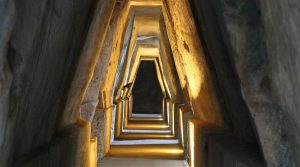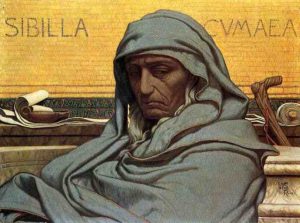The Cumaean Sibyl, according to legend, subjugated by a spell of the god Apollo, prophesied from her mysterious cave and after millennia, survives and hovers in the places where she would have lived and where those who asked her for the prophecies went.

The legend of the Cumaean Sibyl
She perhaps lived in Campania on a hill near the sea, in the territory that is now identifiable between the municipalities of Bacoli and Pozzuoli. The myth tells that the Cumaean Sibyl was a young woman with whom Apollo was madly in love, to the point of offering her whatever she wanted, as long as she became his priestess. She asked for immortality, however forgetting to ask for eternal youth.
And so, as she turned white, her body became smaller and more worn like that of a cicada, to the point that she was placed in a cage in the temple of Apollo, until she disappeared completely leaving only her voice. Over the centuries it has not been easy at all to identify the precise location of the cave where the priestess resided and the legends about her are lost in the mists of time, but the oldest references of a Sibyl's cave are in the VI book of Virgil's Aeneid. .
The meeting of Aeneas and the Sibyl and the descent into hell under the guidance of the prophetess, led to identify this place with Lake Avernus, where a cave was found, still known today as the "Sibyl's Cave". According to Pausanias (196nd century AD) the Cumans had an urn with the ashes of the prophetess, kept in the temple of Apollo. This is a news handed down in the life of the emperor Clodius Albino, according to which the emperor would have asked for prophecies to the oracle in the temple of Apollo (197-XNUMX AD).

Places
Taking a great leap forward in time, from 1925 to 1932 there were still intense searches that identified the cave with a tunnel that crosses Mount Cuma, or a Roman Crypta; a quadrangular room, used as a cell room. The cave identified as the Sibyl's cave dates back to the second half of the XNUMXth century BC
The cave is made up of a long corridor (met. 131,20) with nine arms in the accidental part, of which six communicating with the outside and three closed.
There are some masonry and sepulchral pits which indicate that this part of the gallery served as a catacomb in the Christian age. An arch decorated with paintings and burial niches dates back to the same period, and a little further along the corridor there is a rectangular room.
From here you can see a vestibule on the left formerly closed by a gate, which leads into a small room that is divided into three smaller cells arranged in a cross. This room has been interpreted as the place where the Sybil seated on a throne prophesied. However, the roofing has sometimes led to the hypothesis that his room dates back to the late imperial age.
It is the cave of the Sibilla the lair of the prophecy narrated and handed down by Virgil?

Certainly the search for the true cave of the Sibyl is not yet completed, in fact, it is also sought near the temple of Apollo, where an almost completely underground environment is located.
In any case the Greco-Roman gallery of the ancient city of Cuma it is one of the most fascinating and mysterious places in the region, and is very suggestive for visitors. Entering the narrow passage leading to the oracle room, it is impossible to see the end of the path; sensation that enriches the place with magic and induces scholars to search again.
Here, then, as over the centuries, between mysteries and researches, the cave of the Cumana Sibyl has become one of the most fascinating, mysterious and full of enigmas and atmosphere, and today it is a tourist attraction of magnetic interest.





